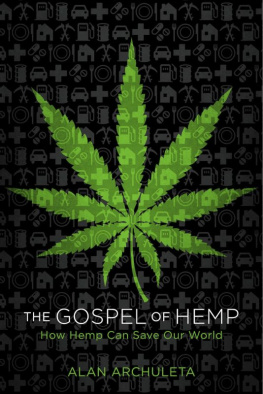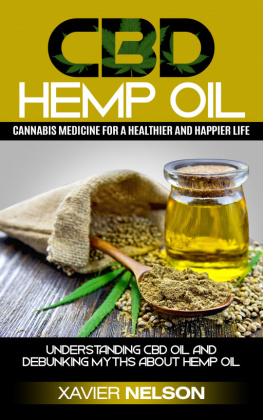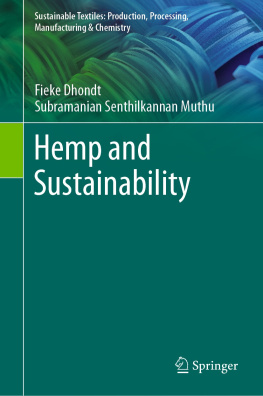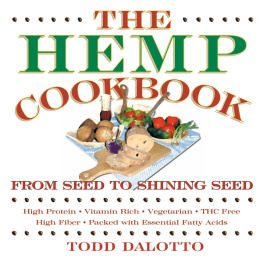CONTENTS


APPENDIX 1
APPENDIX 2
PUBLISHERS FOREWORD
C an there be a special relationship between a plant and mankind? How is it that out of the billions of life forms on earth only an infinitesimally small number have a relationship with humanity? In the animal kingdom we have a special relationship with cows, dogs, cats, horses, and a few other animals that live close to us, with whom we share our lives and who in turn give us benefits. It would be hard to imagine living without these special and intimate relationships which have traveled with us since our earliest historic memories.
But what of the plant kingdom? Are there relationships so close and intimately tied to our own that human development as we know it could not have happened without their help? Trees give us wood to build, and cotton clothes us. Wheat, corn, and other grains feed us. Healing herbs are there to comfort us when we are sick, and numerous other plants are available to support and assist us in our human endeavor. However, there is only one plant helper used all over the world, since prehistory, that gives us food, clothing, building materials, fuel, medicine, and has the power to affect our consciousness, our imagination, and the way we see that world. That plant is hemp, Cannabis sativa.
Hemp appears on the world stage at the dawn of human experience. We find its seeds, rope, and cloth in the oldest tombs. In its role as healer, it is found in our earliest medical texts. We find hemp playing a key role in so many of modern historys great moments. When Gutenbergs presses started rolling, it was hemp paper that received the ink and spread the word of the Bible to an awakening Europe. When the urge to find a new world, a new way of living, gave rise to the age of discovery some 500 years ago, it was hemp that powered this urge, giving the explorers the sails and cordage needed to cross the oceans. When it came time to define this new world, its goals and aspirations, it was on hemp paper that the drafts of the United States Constitution and Declaration of Independence were written. As the young nation moved west it was hemp that covered the settlers wagons.
Even after being outlawed, this fugitive plant has returned to help us in times of special need. During World War II when supplies of raw fiber were cut off by the Japanese, hemp was reintroduced to the U.S. farmer to support the war effort, as the U.S. Department of Agriculture proclaimed hemp for victory. In the 1960s a movement of youth inspired by the ideals of peace and love burst on to the world stage challenging the social, economic, and religious order of the day. This movement of millions upon millions had no leaders, no ideology, no strategy for change, only a deep rooted sense of the hypocrisy of the establishments materialistic world view and a special relationship with a planta plant that has receptors in the human brain waiting to receive its biochemical messages. A message of respect for the earth, its plants and animals, for our bodies and the foods we eat, for cultures and people other than our own was heard and the sea of change it brought is still being played out today.
How extraordinary that hemp should once again appear, but this time in the role of environmentalist and healer. Today hemp offers us a very real and immediate solution to deforestation, the abuses of the petrochemical industry, and the destruction of our top soils as well as help in health care problems as diverse as glaucoma and A.I.D.S.
Only the arrogance of the modern mentality, worshipping at the altar of the church of progress, would reject and deny the history and virtues of hemp. Is it necessary to fear and outlaw this plant? Or are we really trying to outlaw a change in consciousness? Try as we may, a change in culture and consciousness is already happeninga change that is earth-honoring and embraces the healing, environmental, and spiritual qualities of this special relationship between hemp and humanity.
Ehud C. Sperling
INTRODUCTION
H emp is happening. The last several years have rapidly trans formed the concept of a modern industrial hemp industry from fantasy to reality. The physical presence of hemp clothing, paper, building materials, and seed-oil products has made a huge impact on our collective imaginationperhaps even more so than information about the importance of hemp in the past that was the seed of hemps reemergence.
Since the 1930s there has been an effort to indoctrinate people with the belief that hemp is nothing more than a devil weed with roots in hell. But when they are shown a shirt that looks like linen and told it is made from the stalk of the same plant that produces marijuana, a profound shift in awareness begins. The realization occurs that hemp is not a deadly drug but simply a God-given plant, one with a long and distinguished history of service to mankind.

SEEDS, POWDER, PERFUME, CREAM, PAPER, AND FIBERALL MADE FROM HEMP . PHOTOGRAPH BY ANDRE GROSSMAN .
It is significant that this awareness is blossoming while a generation is still alive that remembers the pre-1937 world when hemp was grown on the family farm, that knows the texture and flavor of an old friend when they feel it or taste it. Old-time hemp farmers and their children are still around to attest to the existenceand the valueof industrial hemp.
The resurgence of marijuana use in the late 1960s and the 1970s sparked a deluge of research on all aspects of the hemp plant. The history of hemp clothing and paper merited a chapter or two in books, largely concerned with marijuana, by Ernest Abel, Alan Haney, and Benjamin Kutscheid. By the mid-1980s researchers Gatewood Galbraith, Barry Stull, Jack Frazier, and Jack Herer were focusing their efforts on the other uses of the hemp plant. Government documents, newspaper accounts, and personal testimony began to unravel a vast hidden history of hemps usefulness to mankind and the mysterious nature of government repression of the hemp plant. This hemp information soon spread to the still active pro-marijuana movement, revitalizing it with a new generation of environmental activists who were mainly concerned with ending deforestation and the use of pesticides by switching to sustainably grown hemp for paper and textiles.













